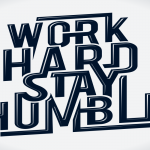Guest Post by: Kofi Aidoo, Intern
I have to start this post with a full confession. I was a recruiter. Right before I switched to UX it was my job to get designers work. First, I worked with industrial designers and then more and more UX designers. In fact, working in placement helped me get closer to the design field in a more meaningful way, and it helped me to get some insight into the industry as a whole. But now as I start my UX career the shoe is on the other foot. It’s me who has to put together a portfolio and reach out to companies and recruiters in hopes of landing a job. And with as much knowledge and experience as I have in recruitment, applying for jobs still makes me nervous. So how do I make sure hiring managers and recruiters see value in my profile? How do I convey not only the things I am able to do, but also the things I want to learn? How do I work with recruiters who will actually care about me as a candidate? Basically – How do I Keep it Real in the UX job search?!
Here are some helpful steps that I’ve found that may also work for you.
#1 Know what you want to do
As a recruiter one of the most frustrating things was dealing with candidates who didn’t really know what they wanted. Junior candidates, especially, were unsure what they could provide or over shot, and perhaps, over expected what they could deliver. So, desperate for a job they say they can do everything. But the reality is very different. Study the field, speak to other professionals and get a good understanding of where your skills can be of most use. Being a wireframe machine isn’t always the best but it’s a door in. If a hiring manager can trust you to do that they will trust you to do other things.

#2 Know who you want to work for but stay open and flexible
Almost as important as knowing what you want to do, is knowing who you want to work for. Though, that’s not always obvious from the beginning. As a recruiter, one of the questions I would always ask candidates is: who were their dream companies? I didn’t ask this because I could always get them a job there at those companies. In fact, nine times out of ten I couldn’t. But it did give me a good sense of the kinds of things they were open to. Know if you’re looking to go in house or be a freelancer. Agency vs Corporate. A fast paced team with little projects or one working on a more long-term basis. For more UX specific roles it’s knowing whether you want to be involved in an agile process or more waterfall, more research focused or closer to UI and execution. Knowing what you want should help you get to where you want to work. These two go hand in hand.
#3 Portfolio Portfolio Portfolio
The portfolio becomes the critical piece in the puzzle. As a recruiter, I would easily look at a portfolio before reading a resume and cover letter. You want to see the skills of the candidate, understand their thinking and see if their aesthetic is a match for the the hiring managers you’re working with. The two biggest questions candidates have to answer when they are creating portfolios are:
1) What is the core message you’re trying to get across?
2) Who’s this portfolio targeted at?
The work in your portfolio should adequately answer these two questions and give a good impression of your thinking and skills. Try and point out the development of a project from start to finish and highlight the process. Wireframes are nice and some recruiters may only focus on that, but stay true to UX as a process and reflect the whole thing. Hiring managers will appreciate seeing the totality of your thinking and insight even if sometimes recruiters miss out.

#4 Screen your recruiters
When working with recruiters make sure you’re screening them too. You want to know that this person will represent you to the fullest, and that they have a good understanding of your skills and some respect for what you’re offering. I try and listen to how the recruiter I’m talking to is responding to my profile. Are they asking questions about my history? Are they noticing my skill-set when they comment on my portfolio? Do I feel like I can trust this person? Those are some of the questions I want answered at the end of our conversation.
Truth be told recruiters go through a lot of candidates and portfolios. Sometimes it’s easy to get jaded but they usually know what they’re doing and know what their hiring managers want. So be upfront with them as to your skills as well as shortcomings. Know that they aren’t miracle workers. They can only try to present you in the best light, so try and give them as much information as possible, without overwhelming them. That way, they can get a full idea of who you are. Also, if they give you some advice: listen! Take it if it makes you look better to hiring managers or aligns with your overall strategy.
#5 Stay Humble and Work hard
For this I will use an example from when I was in engineering. One of the best jobs I had was at a research hospital in Chicago. I had just moved back to the states from Belgium and was looking for a job after the first dotcom bubble burst. I applied for a job in a research lab and was told that they liked my background, but they had already filled the position. But, they did offer me a chance to be in the lab a couple of days a week to help out here and there. I jumped at the chance and accepted, pro bono. For 2 months I was there practically everyday. Helping out where I could, going to meetings, just enjoying being in the environment of learning and doing. After those 2 months a grant they had submitted on the day I arrived was approved and they decided they would give me the researcher position attached to the grant. I was rewarded for my enthusiasm and hard work.

I’m not telling you to take a job with no money, because in this environment, we also don’t want to cheapen the value of UX. However, sometimes you may need to take a risk in exchange for what you can learn and how it augments what you offer as a candidate. You never know where chances could lead.

The good thing about UX right now is that there are a lot of jobs out there. The need for UX grows greater and greater, so it’s a good time to be coming into the field. However, there’s still a lot to navigate. Some companies view UX as only wireframing, others have an evolved process, but may move slower than you want. You also have to try and understand the environment that will help you thrive and grow to be the best UX’er you can be, and that means more than making the choice between an agency or corporate environment. So start by keeping it real with yourself about what you want and what you can do, then demand that others keep it real with you. That’s the way to maximize your job search and craft a great career.
Tell me about your job search adventures and what advice you’d give to someone looking for a job in UX.
Tweet me @K_ID_X